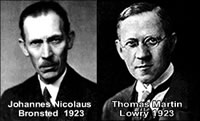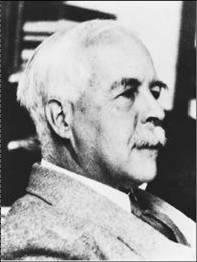Theory of acid-base
These substances are usually dinyakan acid as HA, which is the general formula acid. Substances that are in solution has a pH of 7 is called neutral compounds, pH less than 7 are called acidic substances while substances that have a pH greater than 7 is called alkaline.
Between acids can react base called neutralization reaction. The product obtained from this reaction is salt and water. Although it is said neutralization reaction but in reality the salt formed is not always neutral. Some acids and bases that have been used in everyday life can be seen in the table.
| Name | molecular formula | contained in |
Ascorbic Acid Acetic Acid citric acid carbonic acid hydrochloric acid nitric acid phosphoric acid tartaric acid malic acid formic acid lactic acid benzoic acid |
CH3COOH
C6H8O6 C6H8O7 H2CO3 HCl HNO3 H3PO4 C4H6O6 C4H6O5 HCOOH C3H6O3 C6H5COOH |
Orange kitchen vinegar, tomatoes, vegetables Oranges or vitamin C carbonated Drinks gastric acid fertilizer Detergent, fertilizer wine apple bee stings cheese Food preservatives |
| Name | molecular formula | used in |
| Alumunium hidroksida | AI(OH)3 | Deodorant dan antasida |
| Kalsium Hidroksida | Ca(OH)2 | Plester |
| Magnesium Hidroksida | Mg(OH)2 | Antasida |
| Natrium Hidroksida | NaOH | Duct cleaning pipes, absorbing CO2 in the lab |
| Kalium Hidroksida Ammonium Hidroksida | KOH NH4OH | Solvent disinfectant soap making |
Theory Acid Bases
Acid base theory Arhenius
Svante August Arrhenius
In 1903 Arhenius express a theory known as the acid-base theory. acid-base concepts in a concept known as arhenius beraqua. Acid is a species that can release or increase the ion H + (hydrogen ions) or ion H3O + (hydronium ions) when dissolved in water. While the base is a species that can release or increase of OH (hydroxyl ions) when dissolved in water.
Here are some examples of acid arhenius
HCl(aq) + H2O(l) ──→ H3O+(aq) + Cl‾(aq)
Amino acid monoprotic and polyprotic
Species that are in the water release to release or add one ion H + or H3O + ion are called monoprotic acids. While the species that provide more than one H + or H3O + are called polyprotic acids. Here are some examples of monoprotic acids and polyprotic acids
| monoprotic acid | Name | polyprotic acid | Name |
| HF
HBr HCN HClO HClO2 HClO3 HClO4 HNO2 HCOOH CH3COOH |
hydrofluoric acid hydrogen bromide cyanide hypochlorous acid acid chlorite chlorate acid perchloric acid nirit acid formal acid acetic acid |
H2SO4
H2CO3 H2SnO2 H2SnO3 H2PbO2 H2PbO3 H2C2O4 H2S |
sulfuric acid carbonic acid satanit acid stanat acid plumbit acid plumbat acid oxalic acid sulfide acid |
H2SO4 + H2O ──→ H+ + HSO4‾
HSO4 + H2O ──→ H+ + SO42-
H3PO4 + H2O ──→ H+ + H2PO4‾
H2PO4‾ + H2O ──→ H+ + HPO42-
HPO42- + H2O ──→ H+ + PO43-
NaOH, NH3, N2H2 (hydrazine) are some examples of bases arhenius. Reactions that occur
NaOH(s) + H2O(l) ──→ Na+(aq) + OH‾(aq)
NH3(g) + H2O(l) ──→ NH4+(aq) + OH‾(aq)
N2H2(g) + H2O(l) ──→ N2H5(aq) + OH‾(aq)
CO2 also an acid. Due to reaction with water to form carbonic acid. Carbonic acid formed reacts further with water to produce H3O + and HCO3 ~
These reactions occur
CO2 (g) + H2O (l) ─ ─ → H2CO3 (aq)
H2CO3 (aq) + H2O (l) ─ ─ → H3O + (aq) + HCO3 ~ (aq)
In general, non-metallic oxide which reacts by producing a solution called acid anhydride. Metal oxide or anhydrous base that reacts with water with water will produce hidroksidanya
Na2O + H2O ──→ 2NaOH
BaO + H2O ──→ Ba(OH)2
Teori Asam Basa Bronsted-Lowry

Acid-base theory by Arhenius its use is not as widespread as it can only reveal acid-base phenomena that occur in an aqueous solution. Later in 1923 the theory of acid-base described simultaneously by Danish chemist JN Bronsted and Lowry TM British chemist. Since both of these experts expressed the same theory at the same time the theory is known as the theory of Bronsted-Lowry acid-base. According to both the chemist's acid is a species that can donate a proton (proton donor), whereas a base (proton acceptor), which is a species that can accept a proton from an acid.
For example, the reaction between HCl and water. Reaction as follows
HCl (aq) + H2O (l) ─ ─ → H3O + (aq) + Cl ~ (aq)
From the above reaction is called acid HCl BL because it can donate a proton to water. Because water receiving proton from HCl then water is called alkaline BL. H3O + and Cl ~ are formed can react with each other resulting in HCl and H2O. The reverse reaction is also called Bronstet-Lowry reaction. Where hydronium ion acts as an acid and Cl acts as a base. the reaction can be as an equilibrium, which obtained two acids and two bases. with each of the acids and bases, one located on the left and one on the right is an arrow.
HCl (aq) + H2O (l) ─ ─ → H3O + (aq) + Cl ~ (aq)
acid-base conjugate acid conjugate base
In theory Bronsted-Lowry acid-base conjugate known term. The term conjugate associated with the loss and addition of a proton to form acid-base pair. In the above reaction Cl is the conjugate base of HCl or HCl acid to conjugate base Cl. While H2O is the conjugate base H3O + or H3O + conjugate acid for H2O.
Concept Bronsted-Lowry acid-base wider scope, for it is not just the reaction that takes place in the water, but can be used to predict acid-base reactions that take place in the absence of solvent at all. For example, when HCl is mixed with NH3, will react immediately forming a white solid NH4Cl. By reaction
NH3 + HCl ─ ─ → NH4 + + Cl ~
Alkaline acid conjugate acid conjugate base
From the above reaction is known that this reaction takes place based on the theory of Bronsted-Lowry acid-base. However, this reaction does not involve hydronium ions and hydroxide ions Arhenius that theory does not apply to this reaction.
Based on the theory of BL can be said that a species can act as an acid, and in certain circumstances can also berpean as a base. species-species are called amphoteric substances or amphoteric species. Water and other solvents containing-OH groups can act as a base and can also act as a base.
Lewis Theory of Acids Bases

Bronsted Lowry acid-base theory broader range of acid-base theory Arhenius because not only used for the reactions that take place in water. However Bronsted-Lowry concept has drawbacks because it only discusses the proton handover. Whereas many reactions including acid-base reactions but can not dijelakan use Bronsted-Lowry theory.
Limitations that can not be explained using the Bronsted-Lowry theory, be explained by G. N. Lewis. Acid-base theory developed by lewis just focused on the base. a base is a species that provides electron pair to form a covalent bond. An acid is a species that can accept electron pairs for bonding mebentuk.
Excess Lewis acid-base theory that certain reactions are not included in the theory of Bronsted-Lowry acid-base, apparently by using the theory of such reactions including Lewis acid-base reaction. for example, the reaction between ammonia with boron trifluoride.
H3N + BF3 ─ ─ → H3N → BF3
Compounds containing elements with incomplete valence electrons, such as BF3 and AlCl3 Lewis acids are likely to be. While compounds or ions that have electron pairs beabs likely acts as a base.






0 komentar
Post a Comment